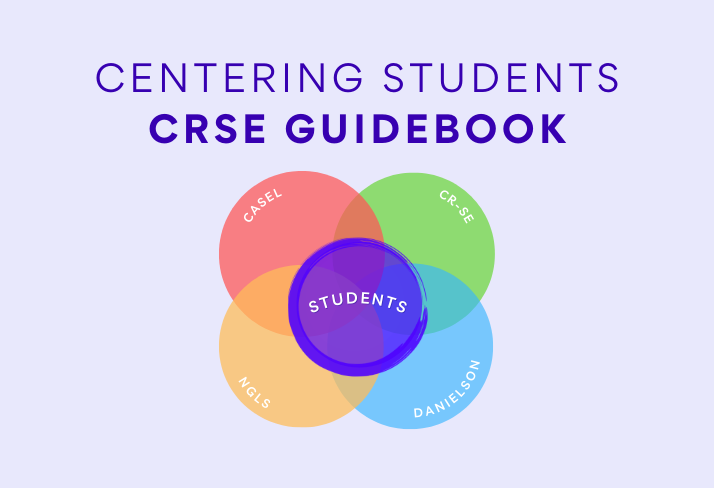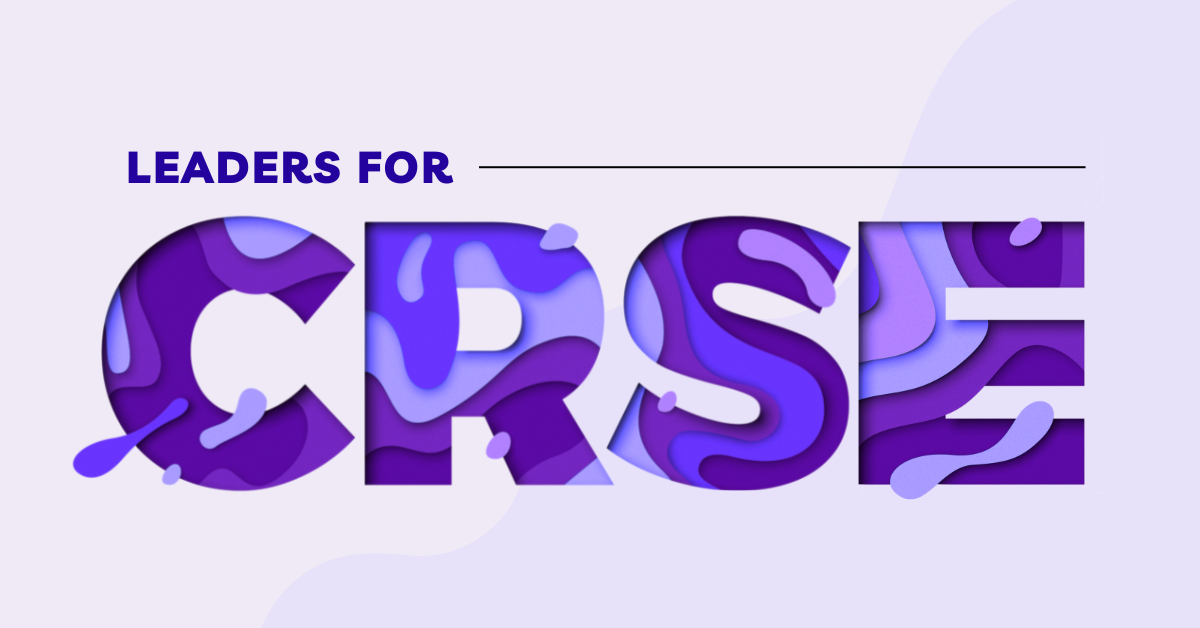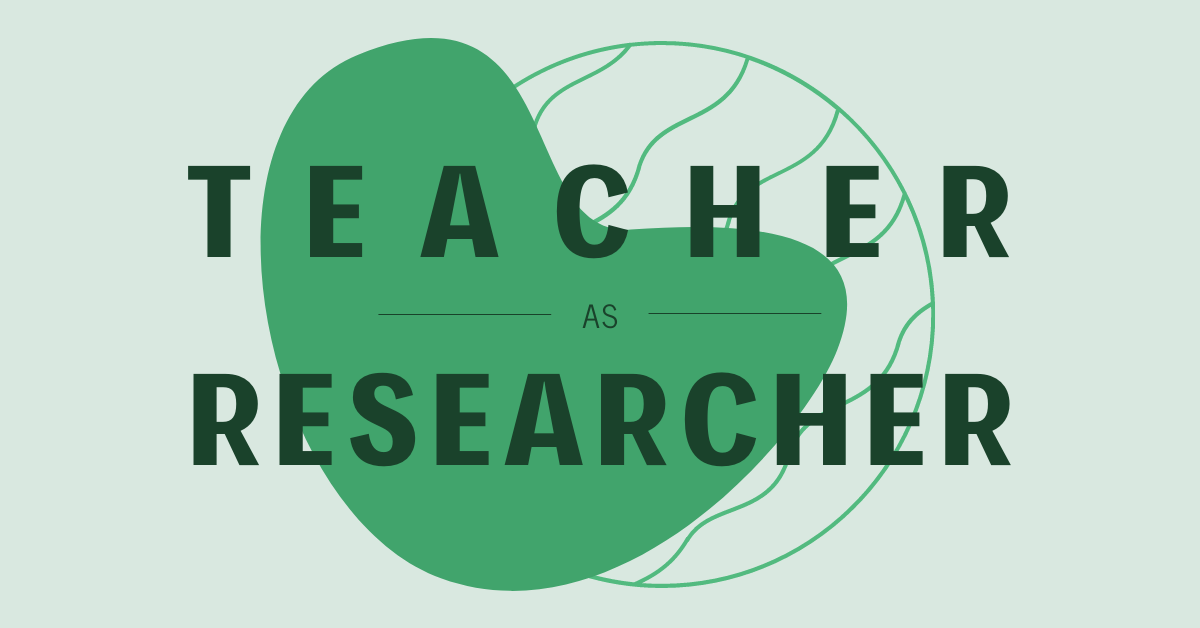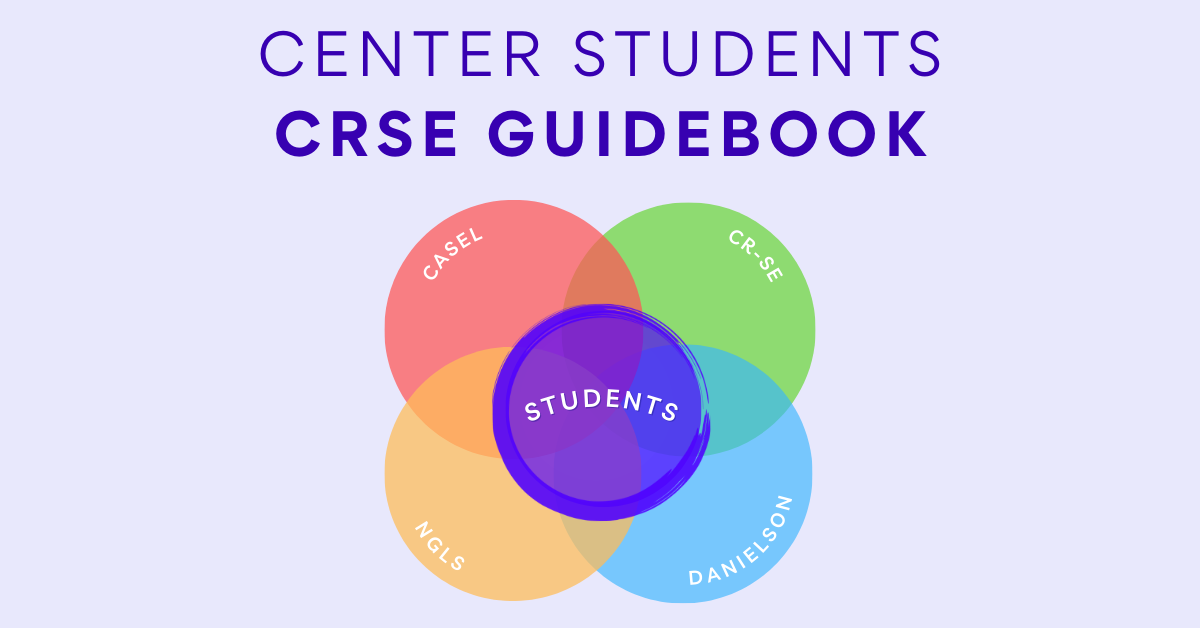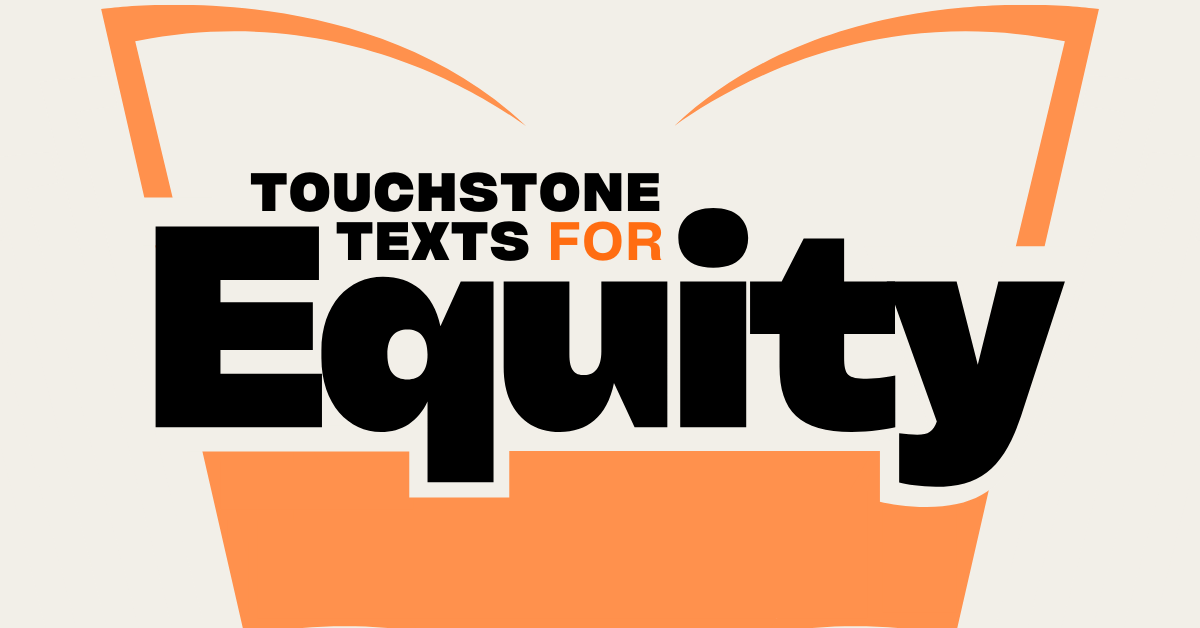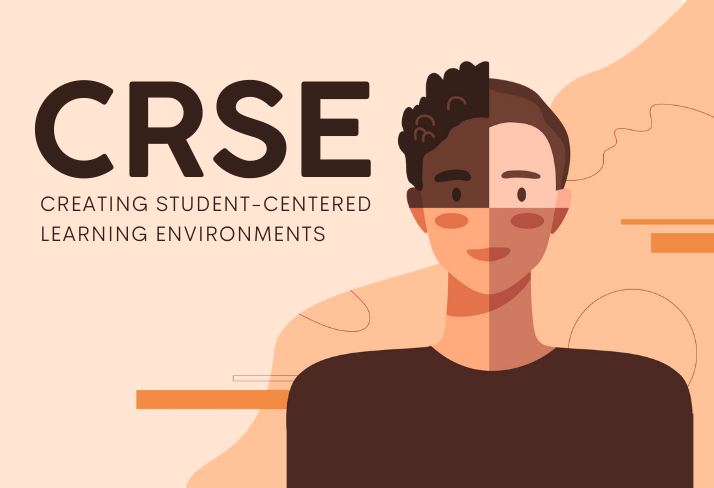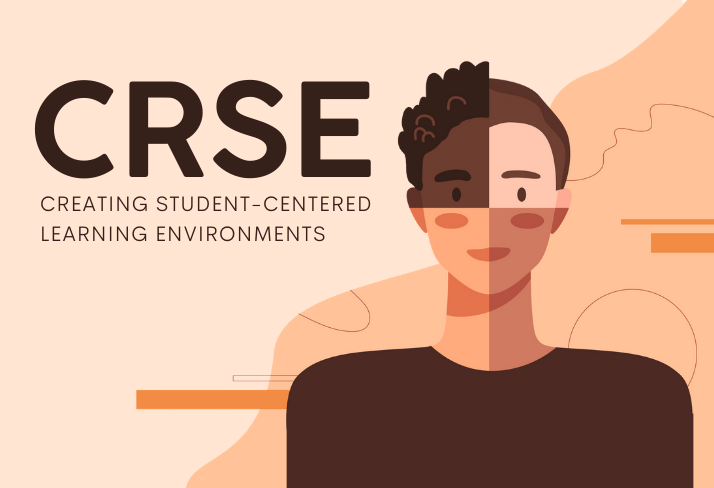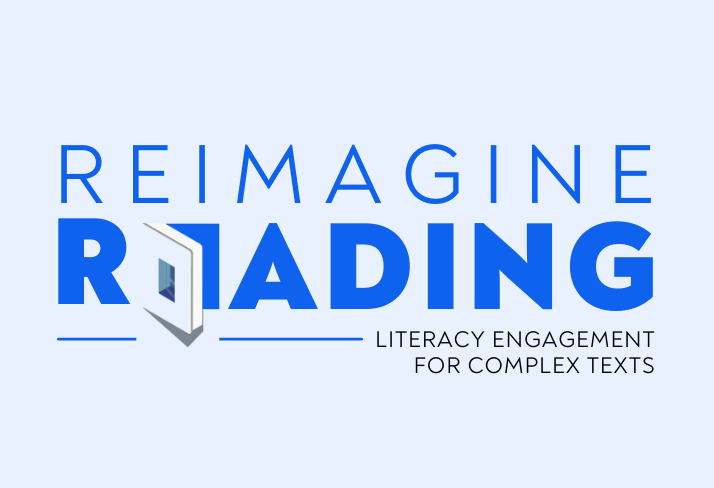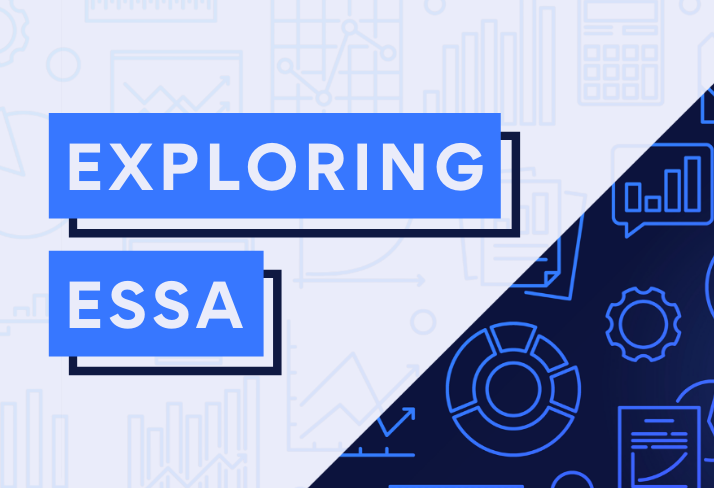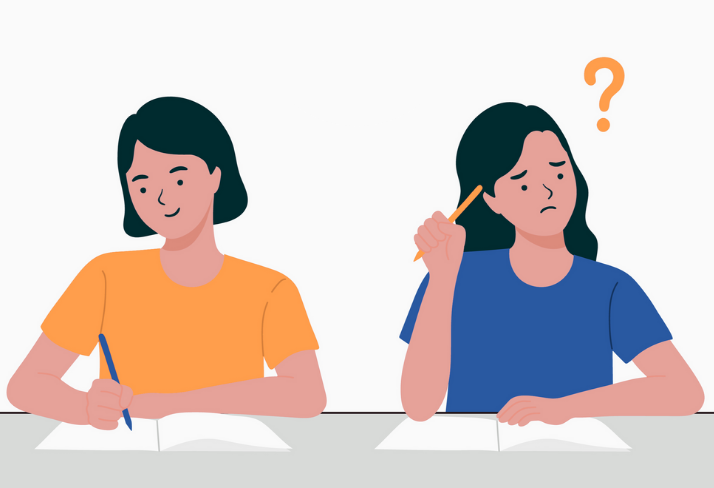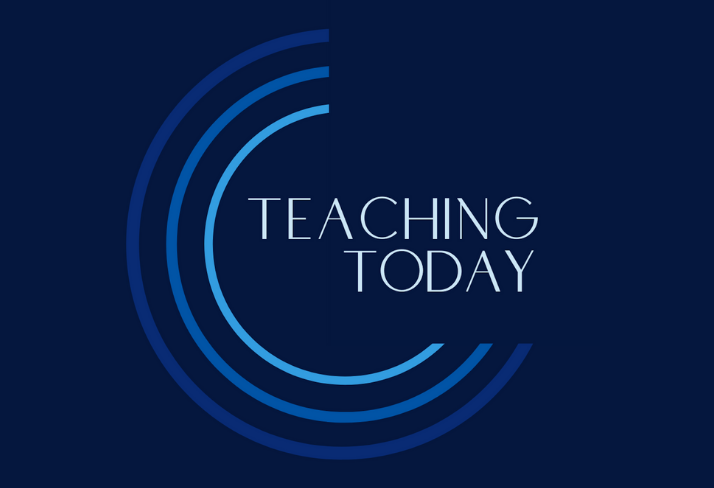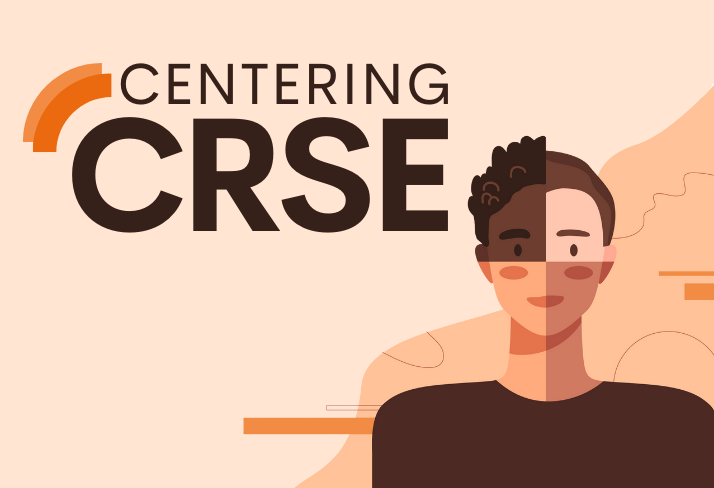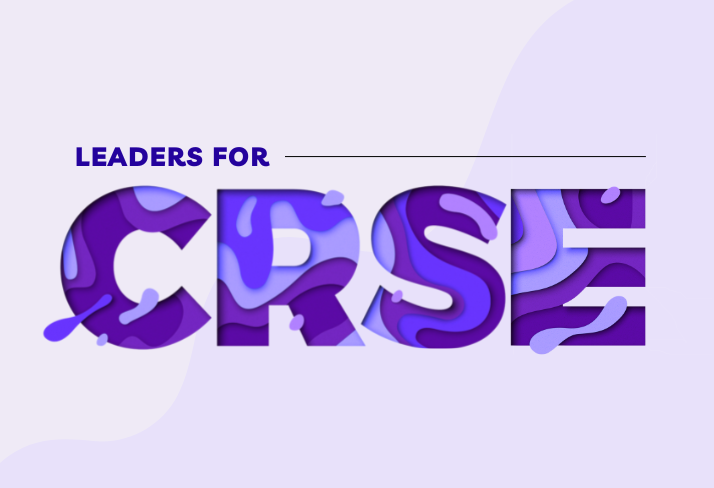|
Three areas of focus for designing rigorous tasks that promote engagement and perseverance.
This article is part of our Close Up On CRSE series
“What motivates people to do hard things? Can you think of a time that you persisted in a difficult task, even if repeated efforts to reach your goal weren’t successful?”
This was a question we posed in a recent workshop as we were exploring the challenges of increasing student engagement. Why do people do hard things? In response to this question, we got a wide range of amazing responses. Educators shared examples of everything from finishing their master's thesis, to running a marathon, and even childbirth. The common factor across these and the many other examples provided was that people persist through challenging tasks when they are able to make a clear connection to a personal goal, believe that they have the potential to reach that goal over time, and seek the sense of accomplishment and pride that comes as a result of hard work. The factors that motivate students to persist in challenging tasks are exactly the same! Whether it’s practicing for a sport, exploring a special interest or hobby, or even staying up all night to get through the next level of the video game, we do hard things when the task is motivating, relevant, and gives us a sense of agency or pride.
Articulating the attribute
Centering Students: A Deep Dive into CRSE Practices outlines Rigorous Instruction as one of the five principles of culturally responsive and sustaining pedagogy. It states: “To ensure instruction is truly rigorous, teachers need to be attuned to the specific learning needs of their students and be able to design and implement a wide range of instructional strategies and materials that are responsive to these needs.” One of the key attributes of Rigorous Instruction is Embedding Intellectually Challenging and Diverse Content into curriculum, unit, and lesson plans. This means that teachers implement challenging tasks and use relevant resources that are responsive to the unique learning needs of their students. It also means that they're designing tasks and activities that are diverse, and reflect the real issues of the world in which we live today. This is important because learning occurs when students are intellectually engaged in culturally diverse and relevant content. In book Drive, Daniel Pink brings together decades of psychological research on motivation theory and helps us understand the mindset that cultivates intrinsic motivation, which leads to perseverance and pride. He outlines the three criteria of purpose, autonomy, and mastery as the keys to unlocking personal drive in adults. For students, this might look like relevant purpose, mastery moments, and structured autonomy. This sounds nice on paper, but what does it mean in the real world? How do we create these conditions intentionally for our students?
In the classroom, the first step to embedding intellectually challenging and diverse content is to design an intellectually challenging task connected to our students’ identities, interests, and instructional goals. This means making connections between our content area and critical thinking tasks that include the demonstration of higher order thinking skills, as found on frameworks like Bloom's Taxonomy, Webb’s Depth of Knowledge, or The Cognitive Rigor Matrix, which is a combination of the two. Setting an intellectually challenging task that taps into students’ ability to analyze, synthesize, or evaluate content information takes time and practice. Choosing an entry point and topic from diverse source material is a key to making the task personally relevant.
After setting the task, then we can begin creating the conditions that cultivate motivation and perseverance.
Relevant purpose
If we look back at the conditions that create perseverance through challenging tasks, we’re reminded that the common factor is people seeing the task as personally relevant to a specific goal or skill they want to achieve. So often in school, the goals we set for students are outside of their own interests. The state sets the goals on high-stakes exams, our district might set the goals for curriculum or course outcomes, and teachers set in-class goals for what students should accomplish, and why. There are almost no formal structures for students to engage in the process of determining what they want to learn, and for what purpose. While there are real constraints that we’re working with when it comes to content standards, there are many opportunities to tap into students’ interests, and to create relevant purpose for the tasks we ask students to engage in.
Mastery moments
Creating mastery moments means that as we look at our arc of instruction throughout a lesson, a week of lessons, or a unit plan, we identify key moments of the learning process and identify those as micro-targets or mini-goals along the route. Creating some built-in celebrations or rewards for hitting these targets inspires a growing confidence and positive pride that comes from meeting a goal.
Structured autonomy
Autonomy is the ability for a person to choose their own process. Students may not have developed all of the skills needed to stay productive with unstructured autonomy, but structured autonomy is empowering and cultivates skills to help students learn how they work best. Structured autonomy means creating pathways that maximize student choice, preference, and independent work with increasing time on task.
When it comes to student engagement, in an effort to create student-friendly tasks, we often associate more engaging with easier. We don’t want our students to struggle or get frustrated during the learning cycle. But easier isn’t necessarily engaging — and it rarely builds the critical thinking and content knowledge that students need to motivate them to take on the next learning challenge.
Embedding intellectually challenging and diverse content into curriculum is critical to engaging students in a productive learning experience that is equally intellectually challenging and engaging. We can all do hard things when we see the purpose, own the goal, and believe that our success is possible.
Create a space where each student sees themselves as someone who belongs, someone who matters, someone with value.
This article is part of our Close Up On CRSE series
One of our core principles is rooted in culturally relevant, responsive, and sustaining pedagogy. We understand that we can’t separate an individual’s identity from their history, their language, their culture, beliefs, or values. As human beings, when we feel seen, heard, and valued, we are more open and engaged. It’s easier for us to feel safe, take intellectual risks, and be open to making mistakes. This is why creating a “Welcoming and Affirming Environment” is the first principle in many CRSE frameworks. But what does that mean, exactly, when it comes to classroom teaching, and what can educators do to create this kind of space?
Building a sense of belonging
In Centering Students: A Deep Dive into CRSE-Aligned Practices — a guidebook we co-designed to analyze CRSE principles and attributes — we investigate what CRSE looks like in practical, pragmatic terms, in the real world. Let’s take a close up look at Welcoming and Affirming Environments: Affirms Diverse Identities.
The notion of an affirming space is important within this attribute. We think about affirm as distinct from tolerate — as in, to acknowledge something exists even though we may not appreciate or approve of it. Affirm is also distinct from accept, which again means we simply acknowledge that the diversity may exist, and may or may not take a stance on whether or not it is of value. To affirm is to be overtly clear that our students are welcomed and valued, and since we cannot separate the individual from their identity, it means their cultural background, spoken languages, values, and beliefs are also welcomed. The NYSED CRSE Framework corroborates this concept by stating that schools are “a space where people can find themselves represented and reflected,” and the CASEL Social-Emotional Framework describes the importance of “integrating personal and social identities” as a critical component of self-awareness. As we describe it, these are spaces that integrate positive linguistic (language), gender, and cultural identities into classroom instruction (how we teach) and curricular materials (what we teach). Affirming diverse identities isn’t only about cultivating the social-emotional connections that help students feel a sense of belonging in the community. It’s also a key component of effective instructional practices, as outlined by the Danielson Framework. Danielson’s domains in content & pedagogy and classroom environment state that “teachers convey that they are interested in and care about their students” and “students feel respected; their dignity is not undermined.” If we’re interested in maximizing learning opportunities for our students, then we want to be conscientious of the benefits of belonging in the learning community. This is true for all of us, but especially for students who identify with cultures that are underrepresented. There is no recipe for affirming student identities, but there are many small entry points that we can locate as we explore small ways we can proactively affirm students’ identities and create a community that celebrates diversity.
Get curious
When making an effort to affirm identities, words matter. It isn’t enough to simply be non-offensive, especially in spaces where we have a historical backdrop of negative bias. What actions can we take to accept and respect who our students are, and build positive connections with them?
Words matter:
Get concrete
How can I acknowledge and affirm the languages represented in my class?
How can I acknowledge and affirm the language my students’ families speak?
How can I affirm youth language in positive ways?
How can I set norms for student-to-student communication?
Get clear
When we observe or overhear students (or adults) using offensive or harmful language or behaviors, it can be a surprising and disorienting experience that sometimes creates an instinctual flight, fight, or freeze reaction. If we can get clear about the ways we will treat our students, and how we expect them to treat one another, we can prepare our responses when harmful ideas are brought into safe spaces.
We want to maintain a grounded presence and offer clear guidance that helps students course correct and that diffuses any potential conflicts. We recommend that teachers work in collaboration with co-teachers or teams to develop a response plan so that when these moments arise, they can be addressed quickly and consistently across classrooms. Whether you’re creating your response plan individually or with a group, here are a few things to consider:
Depending on the situation, addressing harmful language and behaviors can be a simple reminder of the expectations, or may need more in-depth support for conflict resolution or personal reflection to better understand the harm that’s been caused. Work with guidance counselors or social workers to support these more serious situations.
Affirming diverse identities is a challenge to see our students beyond where they sit, the clothes they wear, or their latest hairdo. It’s an opportunity to get to know them beneath the surface, and the privilege to create a space where they see themselves as someone who belongs, as someone who matters, as someone with value.
When they experience this level of community-building, it’s easy to learn.
Exploring the purposeful planning behind creating unbiased opportunities for students to demonstrate their learning.
Equity. A cornerstone of many mission statements, vision statements, and future educational goals. Creating equitable classrooms is essential, but without purposeful and thoughtful planning, it can become overwhelming. So where does our planning begin? At the end: with assessment. In the following conversation with Bob Janes, Secondary Mathematics Supervisor for East Hartford Public Schools in Connecticut, equity in assessment is discussed, and Bob gives educators actionable steps to begin thinking about equity in their own assessments.
Why is it important to ensure that our formative assessments are equitable?
B. Janes: I think it's important to step back and ask ourselves why we assess in the first place. Formative assessments allow teachers to know where a student stands in relation to a learning target and give actionable feedback. Formative assessments also allow students to reflect on their progress and plan next steps.
An inequitable assessment can give the teacher and student a distorted view of that student's learning, which can have lasting negative impacts on a student's learning trajectory. Even worse, an inequitable assessment can cause an otherwise talented student to see themselves as incapable. In a subject such as mathematics, self-efficacy is crucial.
How about summative assessments?
B. Janes: Summative assessments allow multiple stakeholders to reflect on a longer learning progression. In aggregate, summative assessment data can be used to inform large scale decisions including curriculum, instruction, assessment, funding, and staffing. If these assessments are inequitable, they can inform the wrong decisions and breed inequities in other aspects of education.
What makes an assessment equitable?
B. Janes: An assessment is equitable when it allows all students an unbiased opportunity to demonstrate their learning. Below are examples of differences between the features of inequitable and equitable assessments.
I heard you mention that equitable assessments do not take effort and participation into account. Why not?
B. Janes: It goes back to the importance of determining the purpose of an assessment before creating it and checking for alignment again once complete. This ensures the assessment measures what it intended to, and that the conclusions drawn from it are valid.
An assessment designed to test for content standards (e.g. reading for information, graphing a quadratic) should not include effort or participation as a factor in grading because that is not what is being assessed. Some assessments do test for content-based practices, habits, or dispositions (e.g. collaboration, perseverance, problem solving). While this sounds a lot like “effort”, it’s not. A carefully designed assessment that uses a specific rubric can assess these habits or dispositions without grading students for generalized effort or participation.
Equity in our classrooms goes above and beyond this conversation, but thinking about equity in assessment is a great place to start. Equitable assessments can help students reflect on their progress, plan appropriate next steps, and build their self-efficacy, along with allowing educators, administrators, and district leaders to make the best choices for schools.
Simple strategies for imagining an equitable education that benefits all students.
Equity in schools, or a lack thereof, was a problem long before the pandemic began. However, the challenges caused by school closures and remote learning exacerbated the lack of support for minority, special needs, and low-income students, as well as language learners. As we imagine a more holistic, equitable approach to education, we must consider a version of education that addresses students’ academic, social, and emotional needs.
Equity is crucial, especially in times of crisis.
Promising practices for promoting equity
Too often, the terms equity and equality are used interchangeably. While equality means treating every student the same, equity means making sure every student has the support they need to be successful. Simply put, equity in education requires putting systems in place to ensure that every child has an equal chance for success. As President Obama said in his inaugural address, "We are true to our creed when a little girl born into the bleakest poverty knows that she has the same chance to succeed as anybody else."
We have an opportunity and an obligation to provide equitable systems that foster success for all, not just success for some. To assist and explain the process, the University of Southern California (USC) School of Education proposes seven effective ways to promote equity in education. Let’s examine what these suggestions can look like in practice.
In addition to the strategies offered above, we can promote equity in our classrooms by recognizing that all learning is a social and emotional experience. We have all endured collective trauma over the past few years, in addition to the personal losses we’ve experienced. Many students (and teachers) are still finding their way back to their learning.
We may not yet have all the answers for how to address students’ academic and emotional needs in an equitable way, even as we return to the familiar environment of our classrooms. But we do have the opportunity to do more, better!
Encourage curiosity and caring in young learners, and support an understanding and appreciation of differences.
Conversations about race are not easy. They can bring about feelings of fear, anger, and frustration, and as a result, these conversations are often avoided. However, grappling with topics of race and diversity are truly important, especially with young children who are cultivating their understanding and their perceptions of the world. Experts argue that children are never too young to learn about kindness, fairness, and human rights. Research states that children “as young as three months old...may look differently at people who look like or don’t look like their primary caregivers.”
As a parent of a soon to be two-year-old and a professional development consultant who works closely with educators of young children, I am committed to seeking ways to engage in and facilitate my own conversations about race, especially in today’s world, as well as share strategies with educators that they can use in their own classrooms. What follows are a few strategies I’ve curated and adapted from my own musings and readings, as well as some concrete strategies inspired by one of our reimagining education initiatives: Literacy Unbound. These strategies can be particularly helpful when it comes to facilitating conversations about race with young students and cultivating skills, mindsets, and capacities that will serve us well today, and in the future.
The importance of asking questions
One of the most effective ways to grapple with topics of race and diversity is to ask questions. This is particularly effective with elementary students, as they commonly ask many questions of their own. By encouraging their curiosity and caring, and creating a safe space for them to be inquisitive, you can help pacify concerns, address confusions, and support an understanding and appreciation of differences. Additionally, you can raise your own questions focused on topics of race, diversity, and exploring differences to get students thinking and recognizing how they can be advocates of positive change. Here are some examples of questions that I turn to, curated and adapted from websites like PBS.com:
These questions can be a part of morning circle time, a weekly reflection or journal writing prompt, or even as a theme for a bulletin board, where students can share their responses using post-its or index cards (or, while online, students can add their thoughts online to Padlets and Jamboards).
Introducing & exposing students to diverse books
As Dr. Aisha White, Director of the P.R.I.D.E. Program at the University of Pittsburgh, explains, books — especially picture books — are a safe place to start when talking to children about race and racism. She suggests selecting picture books that offer multiple perspectives and explore various entry points for addressing complex topics. Some popular texts she suggests include:
These texts can be read as part of designated read aloud time, as part of a school-wide, character building initiative where the books are read in every classroom, or as a central text that guides and inspires a larger unit of study. But as Dr. White explains, it’s not enough to just read the book. “If a parent (or educator) just reads the book and doesn’t have a conversation — doesn’t start to talk about racial disparities and racial discrimination and racism in America — then it won’t really affect a child’s attitudes toward race…it comes back to…having a background knowledge before speaking with their children, and being brave enough to have the tough conversations.” What does it look like to support students in reading complex texts more closely, more carefully, more creatively, and more critically?
Sparking conversations around texts
Literacy Unbound, one of our signature initiatives, aims to unbind traditional approaches to the teaching of reading and writing using drama and play-based strategies to spark conversations that are inspired by questions raised in a specific, shared text. Teachers and students are brought together in this process as critical and creative thinkers, which helps foster a space for collective inquiry and exploration. Using drama and play can be particularly effective with young students, especially when looking to support engagement and participation, while also providing a safe entry point for complex and challenging conversations. Let’s look at a few strategies from Literacy Unbound to see how they can be effective and what they can look like when applied to one of my favorite texts, The Other Side, by Jacqueline Woodson. The Other Side follows the story of a little Black girl named Clover who sees a little white girl across a fence, but is told by her mom that she can’t cross to the other side of the fence because it isn’t safe.
Facilitating conversations about race with young students is no easy task. It takes courage, patience, and a lot of thoughtful planning and reflection on the part of educators, parents, and caretakers. Moreover, it takes a lot of persistence. Being open-minded and developing understanding, kindness, and an appreciation of others who are different from us is not something that happens after reading one text or engaging in one conversation.
As Glenn Singleton and Curtis Linton note in their book Courageous Conversations About Race: A Field Guide for Achieving Equity in Schools, courageous conversations about race require that we stay engaged and anticipate feelings of discomfort, as well as expect and accept non-closure. We encourage you to create space for these conversations with your students and reimagine the ways in which you can spark curiosity and critical thinking around race and equity in a safe and supportive classroom.
Equitable practices empower students to recognize and develop their own talents and skills, and become agents of change for their futures.
What is equity? How do we define and use it in education?
Whenever there is a buzzword at play in education circles, we like to unpack, define, and interpret how the term applies to educators and schools. Let’s start with the difference between equity and equality. A simple, working understanding of equity involves “trying to understand and offer people what they need to enjoy full, healthy lives." In education, equity means truly striving to achieve the best possible outcome for each individual student. Equality, in contrast, aims to ensure that everyone is offered the same things in order to enjoy full, healthy lives. As educators, the notion of offering all people the same things immediately contradicts our understandings of differentiation. We know that not all students have the same needs. Furthermore, students from underserved backgrounds, generally low-income or students of color, may benefit from a variety of resources to succeed academically. All students benefit from equitable practices. I’d like to suggest that we not only offer students additional opportunities or resources to “catch up” or to “level the playing field”, but instead create a new playing field in education. We can start with our own assessment policies and systems in our classrooms, departments, schools, and districts. Creating equitable education and assessment practices doesn’t end with offering students what they need or deserve to succeed. Equitable policies and practices aim to empower students to recognize and develop their own talents and skills; to become agents of change for their futures. Equity means achieving lasting results for all people, regardless of their socioeconomic, racial, and ethnic backgrounds.
Examining our assessment practices
Equity work in any context may require seeing differently, thinking differently, and even working differently. Therefore, it may be helpful to start by asking ourselves some probing questions about our own assessment practices and beliefs. Consider discussing these questions at your next faculty meeting to norm understandings around assessments, or answering them individually, as a way to understand your own beliefs.
Creating equitable assessments
To work toward equity in education and in assessment, let’s examine our assumptions about educational achievement and assessment. Ibram X. Kendi, author of How to Be an Anti-Racist, explains how traditional testing policies perpetuate racist (and inequitable) ideas and policies in education. He explains that “achievement in this country is based on test scores, and since white and Asian students get higher test scores on average than their black and Latinx peers, they are considered to be achieving on a higher level.” We may not have the power to single-handedly change high-stakes testing policies that use assessment scores to measure educational achievement, but we do have influence over our curricular decisions and how we assess and grade our students. We can create more equitable curricula and assessment practices and policies to create more equitable education. To do this, we must:
Assess what we teach & teach what we assess
There are some basic rules of thumb that we can use to create a more equitable foundation for assessing students. As a starting point, we can simply ensure that we assess what we teach and teach what we assess. Backwards design, from Grant Wiggins and Jay McTighe’s Understanding by Design model, offers a framing to ensure that we first plan our assessments — including all the key teaching points and skills needed for them — as a guide to our instruction. Next, we “backwards plan” our units and lessons to ensure that we are meeting each of our teaching goals as we work our way toward the end of unit assessment. In addition to planning for end of unit assessments, we can also plan our formative assessments, which will help us understand students’ mastery of each discrete skill throughout our lessons. This will also create space to reteach concepts as needed, as well as ensure that we are offering students a range of possible opportunities to learn throughout a unit. When formative assessments reveal or confirm for us which students are struggling or need to revisit a concept or skill, we can differentiate how we reteach or review. If the teaching didn’t stick as we’d hoped the first time around, why would we teach it again in the same way? These practices can help us take initial steps toward ensuring our students are offered fair assessment opportunities, and we can build equity from there.
Differentiating assessments
Traditional assumptions about assessment may lead us to believe that asking students to complete different assessment tasks to demonstrate mastery may not feel fair — but it may actually be more equitable. I admit that early in my teaching career, the concept of differentiated assessments took me a while to grasp and to actually believe in. Many of us use differentiation expert Carol Ann Tomlinson’s helpful framework to guide our daily planning and instruction. We plan differentiated processes using a variety of scaffolds, tools, extensions, student groupings, pacing and modalities. We differentiate content in the form of offering or using a variety of “levels” of texts, math problems, and complexity of tasks. We strive to create a supportive and differentiated learning environment to meet a variety of students’ needs. But, when it comes to differentiating products or assessments, it is a little more complicated. Here are a few simple ways to differentiate assessment products to create equity:
Make assessments rigorous, not rote
Research shows that, especially in marginalized or lower income neighborhoods, lessons for students often focus on rote skills and procedures. Often, this means that students are not expected to achieve, nor learn more rigorous skills and content, when compared with their peers in higher income communities. As we know, rote and procedural learning tends to be boring, and when learning is boring, we often disengage or act out. This may become a serious equity issue in marginalized communities, especially for students of color, where, when students opt out of learning or act out, they may face harsh (or criminalized) punishment. Either way, students lose. Instead of focusing assessments on acquisition or mastery of rote skills or procedures, we can aim to emphasize reasoning and problem-solving skills. Research consistently proves that opportunities for supported, productive struggle can motivate students to stick with a task and to stay engaged as they learn. We all do better when we can engage in productive challenges.
Make assessments relevant
Culturally relevant curriculum and instruction create more equitable education for all students. Zaretta Hammond, in her wonderful book Culturally Responsive Teaching & the Brain, defines culturally responsive teaching as “encompassing the social-emotional, relational, and cognitive aspects of teaching culturally and linguistically diverse students.” She believes that when we teach with these concepts as our guiding lights, we create more equitable education. Similarly, we can create more equitable assessment practices if we offer students experiences that are adapted for their cultural and linguistic diversity and are cognitively appropriate and engaging. Here are a few simple ways to make assessments more culturally relevant or responsive:
Develop and maintain a growth mindset
We often think about how important it is for students to develop a growth mindset, yet, as educators, we need to take a hard look at our own biases and assumptions that things may be “too hard” for students. As Carol Dweck points out in the The Power of Yet, with scaffolding and high engagement tasks, we may find that students surprise us and we can reframe our thinking to become, “they don't get it yet.” Many factors contribute to a student’s mindset and development of a learner’s stance, especially a teacher's language and perspective. Here are a few simple ways to support a growth mindset for assessment practices:
Cultivating strengths and talents
As educators, our job is to cultivate students’ strengths, as well as help them develop in areas of struggle. All students benefit when teachers recognize and cultivate their passions, talents, and skills. Students also benefit when teachers recognize that a class or subject is an area where they need some extra support and that simply making progress is an achievement, even if their skills have not met or exceeded standards. When students are not achieving in a particular subject area, it may be time to think differently about how we assess them. It is possibly a waste of talent and potential if we expect students to spend academic time and energy striving to achieve in an area that continues to be a struggle for them. Instead, we can think more holistically about each student, in an effort to balance supporting improvement in areas of challenge with sponsoring soaring success in areas of strength. We can continue to cultivate and encourage a student’s passions and talents, even when assessing them. Measuring and recognizing ongoing progress and effort are important components of assessing a student’s learning.
Many of us were educated within systems that housed traditional or standardized assessment and grading systems. As educators, we have all consciously or unconsciously based a grading policy or assessment practices on the modeling we learned as students. It can take a leap of faith to imagine new and innovative assessment practices — but we must rethink our notions of fairness and begin to think about developing practices that are equitable for the students in our care.
Get to know the cultures and lives of your students, and evaluate ways in which your instructional practices can support them.
Culturally sustaining practices (CSP) allow, invite, and encourage students to not only use their cultural practices from home in school, but to maintain them. CSP allows students to exist not only in the culture of their school, but also in the culture of their home.
For teachers within New York City, it’s important to note that culturally responsive pedagogy, or culturally responsive-sustaining education according to the DOE, is a requirement for New York City schools. This requirement emphasizes the need for teachers to embrace diversity, get to know their students, and to help students feel welcomed and seen in school. There is no one way of practicing CSP — this would go against the very idea of sustaining students’ cultures! — but there are ways to understand what a CSP approach may require from a teacher. Think about CSP as a mindset rather than a series of practices. But even with a mindset of wanting to be responsive to student needs, it can be difficult to figure out what you should actually do to respond to student cultures, and much of the information out there comes from the world of academia, which can be difficult to translate into practice.
Funds of knowledge
CSP asks: what do my students already know? What are their strengths? What are the strengths of their families and communities? It’s important to investigate the funds of knowledge that your students bring to the classroom. Funds of knowledge can be applied to every area of classroom learning and behavior. A three-year-old who appears to read books backwards may have funds of knowledge stemming from reading in Arabic, which is read from right to left. A fifth grader who fights often on the playground may be defending her friends and family. As teachers, looking at both situations from an asset perspective will change the way we teach these children, whether it’s demonstrating how English texts are read without telling a student that what they’re doing is wrong, or disciplining with compassion and an understanding of the virtuous (though inappropriate) intentions involved in engaging in a fight. Funds of knowledge do not only apply to knowledge about culture and language, which, while important, are not the complete extent of how students bring their cultural experiences into the classroom. Tabitha Kidwell and Luis Javier Pentón Herrera offer an example of how a teacher in the US learned that one of his students, who was from a marginalized indigenous group from Guatemala, had spent much of his life working in fields surrounded by nature. The teacher used this new knowledge to plan a lesson where students went outside and collected rocks for a future project.
Why is CSP needed?
School practices currently reflect the norms of monolingual, white, middle class students, which often excludes students who come from diverse cultural and linguistic backgrounds. Students who are excluded from these norms are often viewed through a deficit lens, which means that teachers or school personnel attribute poor academic performance or behavior problems to faults within the students. Deficit lenses can be directed toward anyone in the school or community. If, for example, a teacher believes that parents in a particular cultural demographic are not involved in their child’s education and blames this for their students not doing well academically, that teacher is looking at the parents through a deficit lens. A deficit lens may mean a teacher believes a student to be incapable of learning due to language, disability, or personal characteristics, or attributing behaviors due to “culture”. Even literature from respected sources may be operating within a deficit lens. In my first teaching job in the US, my school district required us to read a book on how poverty affects children’s development and cognitive abilities. Although the book appeared to have a sympathetic view of children living in poverty (and I lapped it up eagerly at the time), I can see now that it was hugely problematic. The book created a focus on what my students could not do. On their supposed deficiencies that I did not blame them for, but did allow me to envision myself as some sort of savior. My students did not need saving. They needed love and compassion and understanding. The book projected a deficit lens of an entire social class. Incorporating a CSP approach into your practice can help you to question the deficit lens that may exist in your school, and work towards diversifying materials that are available to your students. From a CSP standpoint, students and their families are viewed as people who possess assets for your classroom — a stark contrast to the deficit lens, which implies that they are lacking in some way. This shift in mindset will help you to meet the specific cultural needs of your students as you begin to bring their cultural practices into the classroom.
Getting started
It’s not necessary to know everything about every culture or language in order to incorporate CSP into your classroom. It is important, however, to try to get to know the cultures and lives of the students you’re teaching, and to evaluate ways in which your instructional practices can support your students.
Interrupting and reducing bias requires that we learn how to pause, slow down, and be more mindful in how we make decisions and relate to others.
The Sandy Spring Friends School (SSFS) is a private, affluent Quaker school just outside of Baltimore, Maryland. They have a predominantly white faculty and staff, but at least 50% of their student population across middle and high school are of color, and includes an international student population with students from the East and Africa. The school’s administration has been eager to have the demographics of their student population reflected in their teaching faculty, as well as across their administrative staff. To address this, they began the process of examining their current hiring practices.
When I was initially approached to tackle this work, I was excited — not only do I have experience with anti-bias and anti-racist training, but I was happy to be focusing this work specifically for hiring and the hiring committee of the school. Studies have shown that hiring committees are often implicitly biased when in comes to broadening a homogenous group of staff members. Though we logically understand the need to make a staff more diverse, our implicit bias often prevents us from doing that, and as a result, impacts the hiring process. However, when we are aware of the way implicit bias works, we can take deliberate steps to check ourselves and our colleagues as we move forward. Working around issues of race and bias is by no means easy. Sandy Springs Friends School stands out as an example for schools who want to deliberately and fastidiously address some very hard and painful truths about themselves — both as individuals, and as an organization that upholds the pillars of a rich, traditional Quaker value system. Interrupting and reducing bias requires that we learn how to pause, slow down, and be more mindful in how we make decisions and relate to others (or those that we perceive to be "the other"). Finding a new place, a better place on race (and other forms of difference) does not require a lot of money. But it will require time, internal motivation, and sustained practice in order to form new individual and organizational habits. Here are some initial steps to take:
Across two separate visits to the Sandy Springs campus, we examined what internal, personal bias looks like by reviewing current research, as well as what other schools or educational institutions are grappling with. This information allowed us to begin a plan of action that would benefit the team at SSFS, which included concrete steps that administrators could take to begin improving hiring practices at the school:
In just a matter of months, the faculty and administrators at SSFS made great strides in addressing this action plan. The school completed a diversity audit, which revealed some hard truths about the community. Focus groups reports strongly suggested that students — especially boys — of color felt marginalized at the school. The same was true for students and staff of the LGBTQi population. Teachers of color reported that they felt unfairly burdened by the need to step in an explain racial situations and struggles. International students felt that they did not have any representation in the staff on the school dormitories. Clearly, there were many places that needed attention.
You may be overwhelmed by all of these layers and may be wondering how to begin the work of addressing hard truths in your community. My answer to that would be: start with yourself. Slow, steady, and continued work will be the most effective.
|
|
The Center for Professional Education of Teachers (CPET) at Teachers College, Columbia University is committed to making excellent and equitable education accessible worldwide. CPET unites theory and practice to promote transformational change. We design innovative projects, cultivate sustainable partnerships, and conduct research through direct and online services to youth and educators. Grounded in adult learning theories, our six core principles structure our customized approach and expand the capacities of educators around the world.
|
ABOUT US
525 West 120th Street, Box 182 New York, NY 10027 416 Zankel Ph: (212) 678-3161 [email protected] Our Team Career Opportunities |
RESOURCES
Professional Articles Ready-to-Use Resources Teaching Today Podcast Upcoming PD Opportunities |
COACHING SERVICES
Custom Coaching Global Learning Alliance Literacy Unbound New Teacher Network Student Press Initiative |



